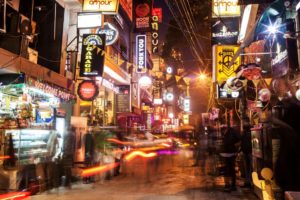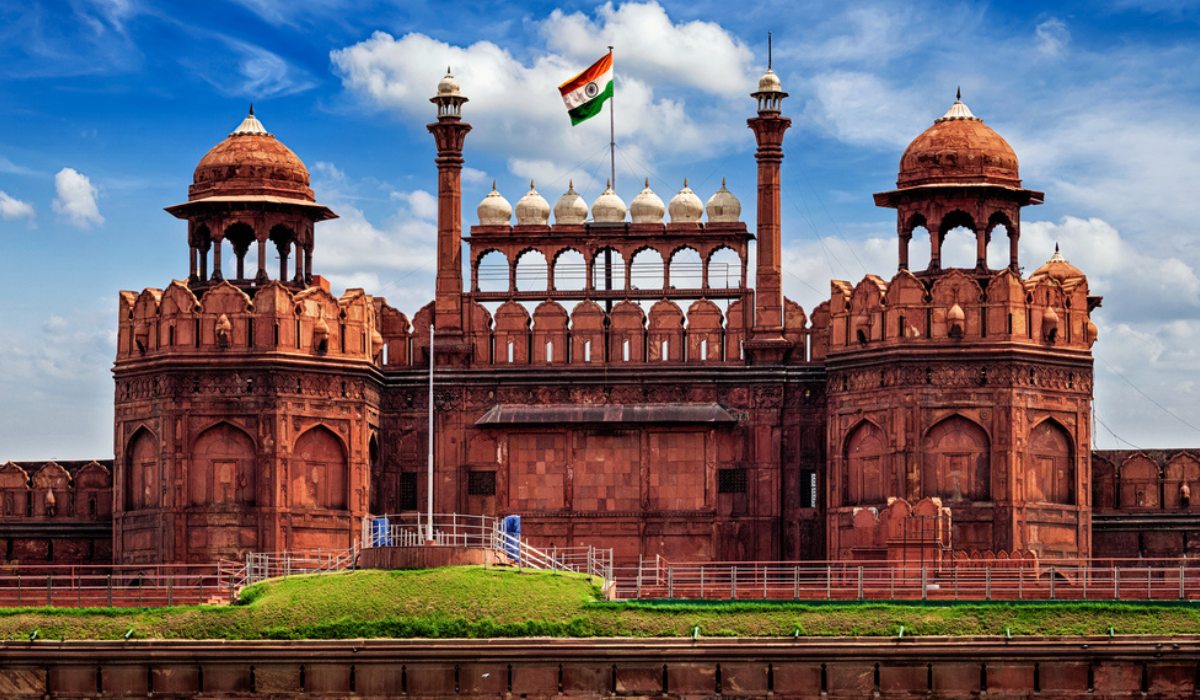The capital of India, Delhi is a cosmopolitan city with a historic old Delhi and the modern New Delhi. From historical monuments to crowded shopping malls, from an extensive network of the modern metro system to Delhi University campus, Dilli has multiple personalities and is considered to be the city with a heart.
The narrow, winding lanes and by-lanes of old Delhi are a testament to the former Mughal rule. Old Delhi houses one of the country’s oldest and busiest market – Chandni Chowk.
Take time to explore historical monuments such as the Red Fort, Jama Masjid, Humayun’s Tomb and Purana Qila if you want to explore the Mughal History. Delhi has famous temples scattered all across the city, a few noteworthy ones being the Akshardham Temple, the Lotus Temple (also known as the Bahai Temple), and the ISKON Temple.
People in Delhi love to eat, and tourists will find themselves spoilt for choice between the multitudes of dishes on offer at every corner of every street. From kebabs and tikkas to Chhole Bhature, Delhi is a melting pot of diverse cultures, and this fact is reflected in the culinary palette of the city. There are a number of cafes and restaurants for the travellers.
Central Delhi is the concentration of the country’s political power, and the must-visit places here include the Connaught Place, drive from outside of Rashtrapati Bhawan on Raisina Hill (visitors are not allowed to go inside), the Rajpath, and the India Gate. The best place to visit this area is in the evening, as all the buildings are lit up, and you can see the Amar Jawan Jyoti at India Gate shining brightly.
Delhi is a shopper’s paradise with some colorful bazaars and upscale markets. The wide variety of markets in Delhi ensures travellers go back home with double the luggage they came with!
Places To Visit In Delhi
India Gate: The All India War Memorial, popularly known as the India Gate, is located along the Rajpath in New Delhi. The imposing structure of India Gate is an awe-inspiring sight and is often compared to the Arch de Triomphe in France, the Gateway of India in Mumbai and the Arch of Constantine in Rome. This 42-meter tall historical structure was designed by Sir Edwin Lutyens and is one of the largest war memorials in the country. India Gate is also famous for hosting the Republic Day Parade every year.
Qutub Minar: Qutub Minar is a minaret or a victory tower located in Qutub complex, a UNESCO World Heritage Site in Delhi’s Mehrauli area. With the height of 72.5 meters (238 ft), Qutub Minar is the second tallest monument of Delhi. Its construction was started in 1192 by Qutb Ud-Din-Aibak, founder of Delhi Sultanate after he defeated the last Hindu Ruler of Delhi. He constructed the basement, after which the construction was taken over by his son-in-law and successor Iltutmish who constructed three additional stories. The fourth and fifth storeys were built by Firoz Shah Tuglak.

Swaminarayan Akshardham Temple: An epitome of Indian culture, spirituality, and architecture, Akshardham Temple is a famous Hindu temple and a spiritual-cultural complex. Also known as Swaminarayan Akshardham, it is dedicated to Lord Swaminarayan. Akshardham has made its way to the Guinness Book of World Records as the World’s Largest Comprehensive Hindu Temple.
Humayun’s Tomb: As the name suggests, Humayun’s tomb is the final resting place of the Mughal Emperor Humayun. Located in the Nizamuddin East area of Delhi, it is the first garden-tomb in the Indian subcontinent. This splendid piece of architecture was commissioned for construction by Humayun’s chief consort Empress Bega Begum in the year 1569-70 and is one of the very few structures that used red sandstone on such a massive scale at that time. The design of Humayun’s tomb is a typical Mughal architecture with Persian influences and was conceptualized by Persian architect Mirak Mirza Ghiyath. Owing to its magnificent design and illustrious history, Humayun’s Tomb was featured in UNESCO’s World Heritage List in the year 1993.
Hauz Khas Village: An affluent neighborhood in South Delhi, Hauz Khas has been well known since medieval times. Hauz Khas Village retains the old charm of the place with remnants of Islamic architecture roughly cultured by splotches of urbane refurbished upmarket. ‘HKV’ is known for its electric nightlife with countless cafes, bars and pubs along with art galleries, and boutiques.
Museum of Illusions: The Museum of Illusions in Connaught Place, New Delhi is India’s first optical illusion museum. It is a fun place to challenge the senses by exploring exhibits which include holograms, a supposedly rotating cylinder, a room with no gravity, rooms with mirrors that distort reality and much more.
National Gallery Of Modern Art: India is a country of art lovers, and National Gallery of Modern Arts (NGMA) is no less than heaven for them. Following its motto of delivering an excellent world of art to its visitors, National Gallery of Modern Art, Delhi, preserves paintings and other artistic pieces dating back to 1850s. NGMA at Delhi is the main museum located in the erstwhile Jaipur House. It was established on March 29, 1954, by the Indian Government. Covering an area of 12,000 meterssquare, it is the largest when compared to its subsequent branches in Mumbai and Bangalore. The gallery helps people to connect the works of modern art with their vital passions of the human spirit.
Lotus Temple: Located in the national capital of New Delhi, the Lotus Temple is an edifice dedicated to the Baha’i faith. The magnificent structure of this building unfolds in the form of a stupendous white petal lotus and is one of the most visited establishments in the world. The design of this shrine was conceptualized by Canadian architect Fariborz Sahba and was completed in the year 1986. This temple seeks to propagate the oneness of the Almighty and is open to all regardless of their nationality, religion, race or gender. The Lotus temple is among the seven Baha’i House of Worship in the world.
Lal Quila: The Red Fort is a historical fortification in the old Delhi area. Shah Jahan constructed it in the year 1639 as a result of a capital shift from Agra to Delhi. Used as the main residence of the emperors of the Mughal dynasty, this imposing piece of architecture derives its name from its impregnable red sandstone walls. In addition to accommodating the emperors and their households, it was the ceremonial and political center of the Mughal state and the setting for events critically impacting the region. Today, this monument is home to several museums that have an assortment of precious artifacts on display. Every year, the Indian Prime Minister unfurls the national flag here on the Independence Day.
Lodhi Garden: Located near the Safdarjung tomb and Khan Market of Delhi, the Lodhi Garden is a luscious garden that houses the tombs of Sayyid ruler Mohammed Shah and Lodhi king Sikandar Lodhi. The construction of this great work of architecture took place under the Lodhi reign sometime in the 15th century. In addition to encompassing the final resting place of two great leaders, the Lodhi Garden also has the Shisha Gumbad and Bara Gumbad within its perimeter. The architecture here shows a mix of work by Sayyidis and Lodhis and is the epitome of magnificent engineering that echoes of Delhi’s illustrious history. Currently, this place is maintained by the Archaeological Survey of India.
Best time to visit Delhi
While October to March is the best time to visit Delhi because of cool weather. However, some weeks in late November to January should be avoided because of heavy smog cover. February and March have great weather and relatively clean air to travel outside. Delhi experiences extreme temperatures in summer and winter seasons. The summer months (April to July) are scorching hot in Delhi as the temperature might rise to 45 degree Celsius. Temperatures fall a little during the monsoon season (August to September) and certain days can be good for roaming around.
How to Reach Delhi
Being the capital of the country, New Delhi is well-connected to all the major parts of India and the world. The Delhi Airport serves for domestic as well as international flights. New Delhi also is the main railhead, being well-connected to all major cities in India. State buses also run to and from neighboring cities.







